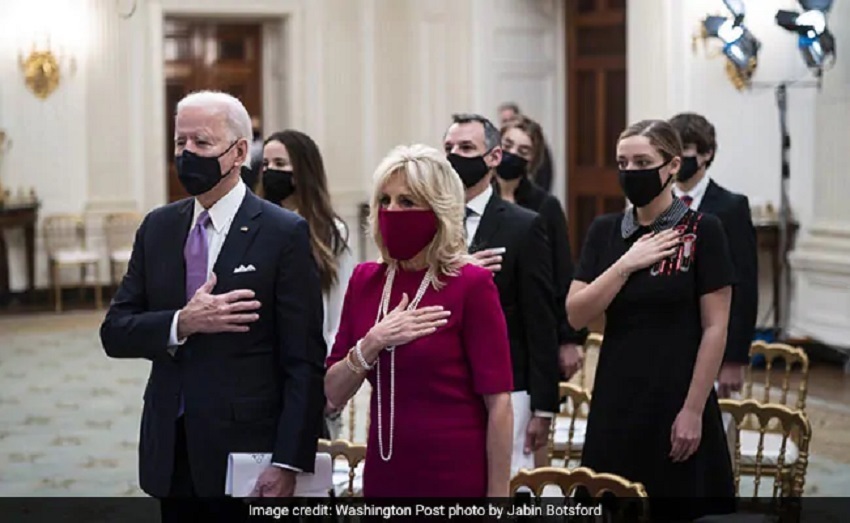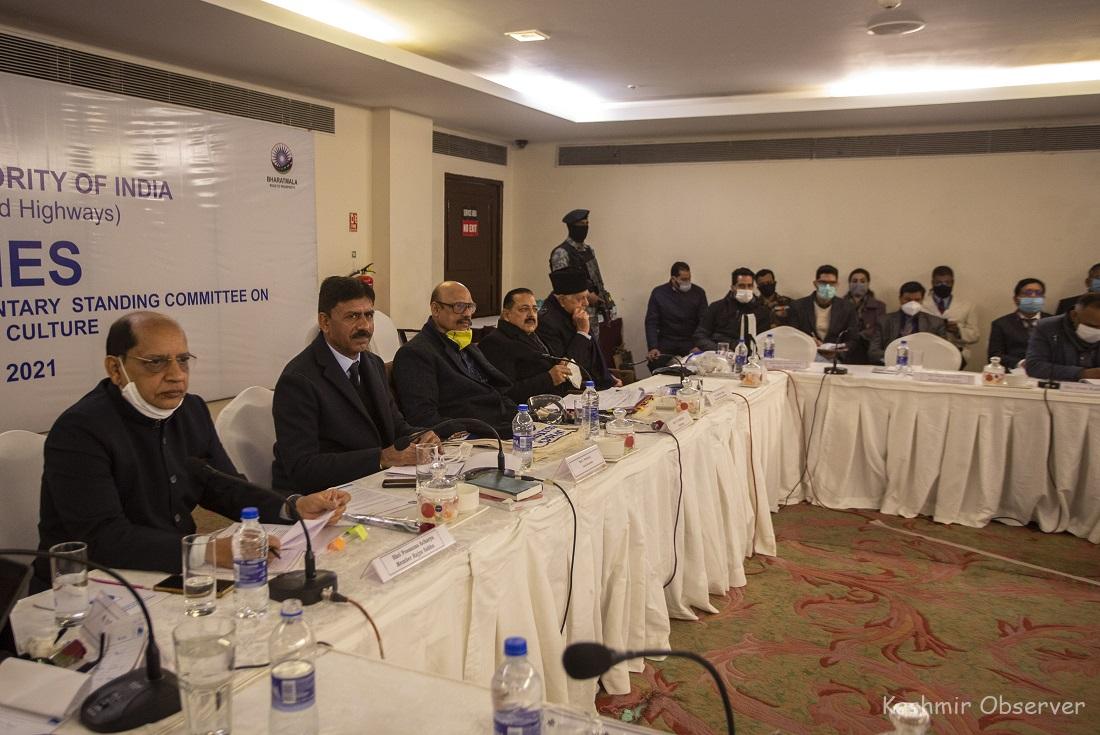
Ashley Parker, Matt Viser, The Washington Post
Washington- President Joe Biden raced Thursday to show he was addressing the array of crises awaiting him on his first day in office, issuing executive orders aimed at combating the coronavirus and preparing measures to take on the struggling economy and other problems.
Biden and his team found themselves immediately on what the president called a “wartime” footing, describing fighting the coronavirus as “a national emergency.” Against an already calamitous backdrop of a pandemic that has left more than 408,000 Americans dead, an additional 900,000 people filed new unemployment claims last week, underlining a devastated job market.
In remarks in the White House State Dining Room, Biden outlined a new national strategy for combating the virus, signing 10 executive orders and other documents to streamline the federal government response, move toward reopening schools and businesses, ensure safer travel and increase vaccinations, among other goals.
He called on Americans to “mask up” for the next 100 days, saying that doing so could save more than 50,000 lives. Biden’s tone was notably sober, contrasting not only with former president Donald Trump’s rhetoric, which was often full of superlatives and grand promises, but also with the tone of other presidents on many occasions.
“Let me be very clear: Things are going to continue to get worse before they get better,” Biden said, adding that the death toll would likely top 500,000 next month. “And let me be equally clear: We will get through this. We will defeat this pandemic.”
Biden criticized Trump’s vaccine rollout as “a dismal failure” and called his own goal of administering 100 million vaccine doses within 100 days “one of the greatest operational challenges our nation has ever undertaken.”
But averaging 1 million doses a day appears to be a goal that is already being surpassed. The average number of vaccines administered over the past week was about 936,000, according to a Washington Post tally using data from state reports and the Centers for Disease Control and Prevention. On Thursday, the number was 1,057,369.
Biden bristled on Thursday when asked whether his goal was ambitious enough. “When I announced it, you all said it’s not possible,” he said. “Come on, give me a break, man.”
At the same time, Dr. Anthony Fauci, who is spearheading Biden’s covid-19 response, said he felt far freer than he had under Trump to provide accurate, science-based information. “The idea that you can get up here and talk about what you know, what the science is, and know that’s it – let the science speak – it is somewhat of a liberating feeling,” Fauci said.
Biden plans to move quickly on other fronts beyond coronavirus as well. On Friday, he will sign executive orders tackling the economy, which continues to struggle, with nearly 16 million people claiming benefits as of Jan. 2, the last week the information was available.
And he plans to continue apace in the coming days, outlining a “Buy American” action Monday, followed by a focus on racial equity Tuesday, climate change Wednesday, health care Thursday, and immigration Friday.
But the pandemic is arguably the country’s starkest problem, given the daily death toll. For nearly a year Biden has criticized Trump for not making full use of his executive powers to ramp up production of coronavirus tests and personal protective equipment.
In his actions and remarks on Thursday, he authorized the use of the Defense Production Act to increase efforts to combat the pandemic and increase vaccine distribution. “This is a wartime undertaking,” Biden said, noting that more Americans have died of covid-19 than in all of World War II.
The president’s early moves are the culmination of months of planning. His team began laying the groundwork last April, hiring staff and drafting proposals with an eye toward the opening days of a Biden presidency.
“We’re going into war – but it wasn’t a surprise attack. This isn’t Pearl Harbor. It’s more like D-Day,” said Ted Kaufman, a close Biden adviser who led the transition. “This is the first days of the battle, and if you have really, really good people you can fight on all the fronts.”
Adam Jentleson, a former aide to then-Senate Majority Leader Harry Reid, D-Nev., said the Biden team is still grappling with the enormity of its challenges.
“You’re always having to figure things out on the fly, but the ground is shifting under them faster than any other new administration in recent history,” said Jentleson, the author of “Kill Switch,” a book about the Senate. “So they’re having not just to play three-dimensional chess, but they’re playing three-dimensional chess in an antigravity chamber with the pieces flying off the board.”
Biden’s schedule Thursday was itself designed to suggest focus and normalcy. He held a single public event, followed by a public briefing from Fauci and White House press secretary Jen Psaki.
That contrasted with many of Trump’s days as president, which often included early-morning or late-night tweets on various subjects, as well as comments from Trump that might deliver insults, veer sharply from aides’ expectations or complain of persecution.
Even on Biden’s first full day as president, there were signs that a tighter organization would only go so far in overcoming challenges.
The White House has been reluctant to stake out a firm position on the timing of Trump’s impeachment proceedings, which could bog down the Senate’s ability to move forward on Biden’s $1.9 trillion relief package and his Cabinet nominations.
Psaki on Thursday declined to say whether Biden had an opinion on eliminating the Senate filibuster, which could make his priorities easier to pass but would significantly alter the chamber where Biden served for 36 years.
Despite Biden’s appeals for unity, Republicans are already citing objections to many of his initial plans – including an ambitious overhaul of the nation’s immigration system – and are widely expected to object to portions of his covid relief bill.
While Trump’s administration yielded the expedited production of a coronavirus vaccine, Biden’s clearly has some catching up to do. Trump initially downplayed the virus, diminished his administration’s health experts, mocked actions like mask-wearing and left much of the pandemic response to the states.
Trump in many ways also undermined efforts to combat climate change and racial inequity – Biden’s two other top priorities – leaving the new president to begin reversing actions from the previous four years before beginning to implement his own agenda.
And in baselessly claiming the election was stolen and encouraging his angry supporters to assault the Capitol, Trump left Biden a nation riven by partisan politics, with a portion of the population refusing to accept Biden as the legitimately elected leader.
Former Barack Obama chief of staff Rahm Emanuel – who famously quipped about the Great Recession’s financial collapse that “you never want a serious crisis to go to waste” – said that while the individual crises facing Biden faces are not unprecedented, the combination is unlike anything in modern history.
“Lincoln had the Civil War, Wilson had the pandemic, Roosevelt had the depression, Kennedy had the height of the Cold War, and Johnson had unprecedented civil and social strife,” Emanuel said. “Biden has D, all of the above.”
“It brings a different set of urgency,” Emanuel added. “The normal boundaries of procedures and expectations, that weight gets lifted and you . . . can do things you once thought were impossible.”
In the opening day of his administration, Biden signaled a split from Trump in both style and substance.
“We talked constantly in the campaign about hitting the ground running, but we hit the ground sprinting on day one,” said deputy White House press secretary T.J. Ducklo.
Emanuel said the Biden team’s actions – both implicit and explicit, both substantive and ceremonial – were designed to convey propulsion. “No stalling. No stopping. No wasting time. With a sense of urgency, it’s forward movement,” he said. “Suit up, get ready, let’s go. It’s all of one piece: Momentum.”
Biden has made a flurry of moves – signing 15 executive actions, as well as two agency directives – inking some while still in the Capitol, moments after being sworn in. Some of those actions, like the ones on Thursday, focused on the coronavirus, while others addressed the economy, climate change and racial equality.
It’s an effort to show he is responding to a cluster of problems – a health crisis that snowballed into an economic one before colliding with a social one – with few parallels in modern history. The closest, perhaps, has been the devastation confronting Franklin D. Roosevelt, the president about whom Biden increasingly spoke during his campaign and whose large portrait he installed in the Oval Office.
Roosevelt, like Biden ended up facing a crisis in his first days in office – in his case, a banking collapse – that was different from what he expected when he began his campaign.
“When Biden started running for the presidency, he articulated all the things he thought he and the Democratic Party and the country should be doing,” said Eric Rauchway, a historian and author of “Winter War: Hoover, Roosevelt, and the First Clash Over the New Deal.” “He’s not going to do any of those. He’s dealing with the bad vaccine rollout. . . . It’s obviously become a priority and been forced upon him in a way he wouldn’t have chosen.”
In some ways, Rauchway added, Biden’s early days and weeks may be guided as much by the landscape that Trump left him than his own affirmative plans.
“A crisis and misconduct by the outgoing president,” Rauchway said, “can set the agenda for the incoming president.”
Follow this link to join our WhatsApp group: Join Now
Be Part of Quality Journalism |
Quality journalism takes a lot of time, money and hard work to produce and despite all the hardships we still do it. Our reporters and editors are working overtime in Kashmir and beyond to cover what you care about, break big stories, and expose injustices that can change lives. Today more people are reading Kashmir Observer than ever, but only a handful are paying while advertising revenues are falling fast. |
| ACT NOW |
| MONTHLY | Rs 100 | |
| YEARLY | Rs 1000 | |
| LIFETIME | Rs 10000 | |













